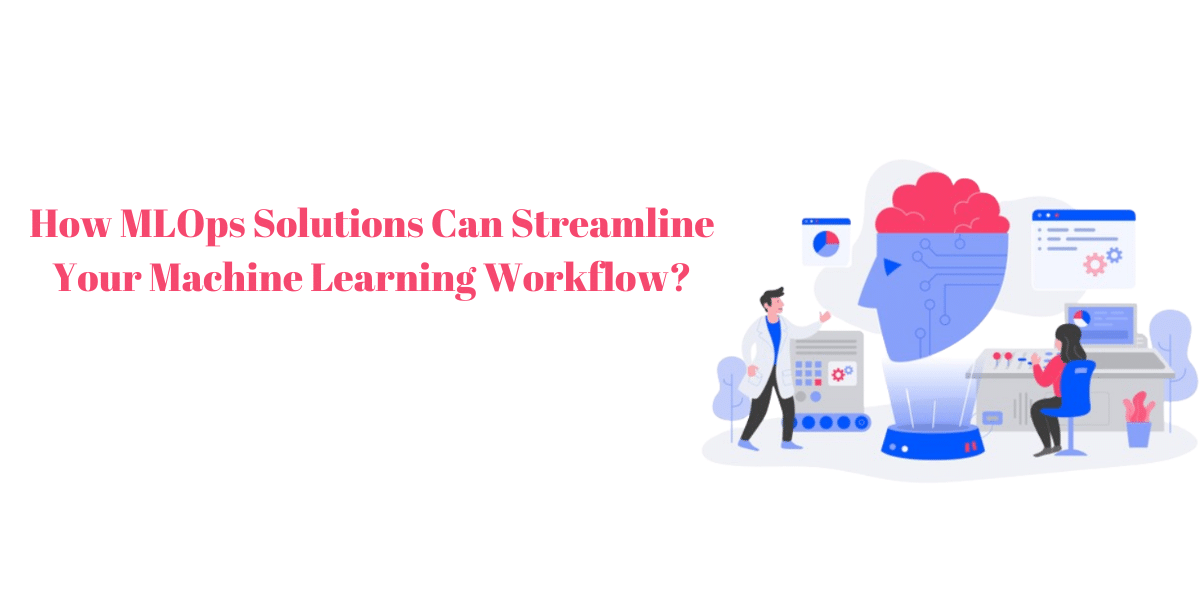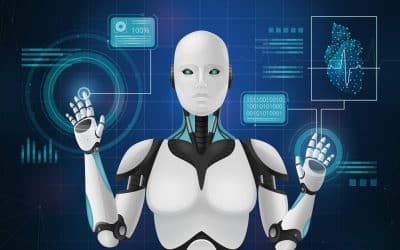Machine Learning (ML) has become an indispensable asset to businesses of all sizes, giving businesses access to knowledge-gaining capabilities while automatically optimizing data use. Yet successfully setting up and overseeing daily ML tasks is complex; therefore, the MLOps solutions plays an essential part.
“MLOps” was first coined in 2018 by Microsoft’s John Akred and David Aronchick. They laid out the fundamental concepts and methods of MLOps, which included continuous integration, infrastructure delivery code monitoring and alerting, and experiment management. MLOps continues to develop, and many companies use Its methods to enhance the quality of their ML Techniques pipelines’ performance, reliability, and capacity.
In this blog post, we’ll examine the main ideas and strategies of MLOps and offer practical instructions for implementing and streamlining MLOps within your organization.
What Are MLOps?
MLOps, which stands for “Machine Learning Operations,” has rapidly become an essential element in the constantly evolving world of data science. It connects data science and traditional operations (ops), emphasizing automation and streamlining the complete machine learning (ML) process. MLOps is a simple term that describes how it efficiently aids in implementing, monitoring, and managing ML models.
MLOps draws on DevOps principles, a collection of tools and practices for improving efficiency and collaboration in software development. However, there are some fundamental distinctions among DevOps and MLOps. In particular, MLOps concentrates on the specific challenges associated with ML, such as managing large models and large datasets. MLOps typically involve tight integration with instruments and platforms for data science like Jupyter Notebooks and TensorFlow.
Critical Components Of MLOps
We’ll take a closer overview of the main parts of MLOps
Collaboration and Communication
MLOps helps improve collaboration between multi-functional teams like engineers, data scientists, and operations. By breaking down barriers and encouraging collaboration, MLOps ensures everyone involved within the ML pipeline is in the same boat. Instruments like version control systems and collaborative platforms facilitate an easy sharing of code, models, and data, resulting in greater effectiveness and speedier development times.
Automated Model Training and Testing
One of the main features of MLOps is automation. Automated models for training and testing can reduce the chance of errors made by hand and accelerate the development process. Continuous Integration and Deployment (CI/CD) pipelines simplify the testing and deployment of models, allowing teams to test models swiftly and safely. Automation of the process also guarantees that models deployed remain based on the most recent data and codes, improving forecasts’ precision.
Versioning and Model Tracking
MLOps has an extensive versioning system and model-tracking features. Similar to how code versions are monitored in traditional Software development, MLOps software allows the revision of data models, models, and settings. It ensures traceability and reproducibility and will let teams know the model’s development process, what information was used to train it, and what parameters were utilized. This is vital in auditing, compliance, and debugging in regulated areas.
Infrastructure as Code (IaC)
MLOps utilizes infrastructure-as-code principles to provide and manage the computing resources needed for ML tasks. IaC allows teams to create and update infrastructure configurations, making increasing or decreasing resources more straightforward, depending on needs. This method ensures uniformity between testing, development, and production settings, reduces the chance of deployment-related issues, and simplifies handling complex ML infrastructure.
Continuous Monitoring and Model Governance
When models are in use, MLOps ensures continuous monitoring and oversight. Monitoring tools assess the model’s performance in a way that detects anomalies and changes in real-time. Model governance frameworks assist in enforcing policies related to the behavior of models, their use of data, and the compliance of models. This method of proactive monitoring and governance improves the security of ML models and permits rapid intervention when there are problems.
Scalability and Resource Optimization
MLOps solves the problems associated with expanding ML workflows. Teams can seamlessly scale their ML apps using containers and orchestration tools like Docker and Kubernetes. This practice ensures that the models can handle different workloads, from testing and development to production deployment. It also improves resource utilization, stops over-provisioning, and reduces infrastructure expenses.
Feedback Loops and Model Iteration
MLOps encourages the creation of feedback loops to improve the model’s performance in production and the environment for development. Data scientists can get insights into how models perform in real-world circumstances. Feedback loops allow for constant model iteration. This will enable groups to adjust models to changes in conditions and increase the accuracy of their predictions over time.
Why Is MLOps Important?
MLOps is crucial because it can help organizations conquer the difficulties of deploying and controlling ML within production. The challenges that arise can be enormous and may include:
ML development typically involves working with data scientists and engineers with different abilities and preferences. MLOps aids in improving collaboration by establishing standard processes and tools to support ML development. ML pipelines can be complicated and time-consuming to create and maintain. MLOps improves efficiency by automating critical tasks, including model training and deployment.
The reliability of the ML model can prove to be fragile and vulnerable to degradation as time passes. MLOps aid in improving the reliability of models by using continuous integration and monitoring techniques. Through implementing MLOps, businesses can boost the speed of their ML pipeline in terms of quality, reliability, and performance. This results in a faster time to value and more tremendous success in ML In Engineering deployments.
Pros and Cons of MLOps Solutions
Machine Learning Operations (MLOps) are essential to current machine learning (ML) processes. MLOps is designed to enhance the procedure of developing tests and deploying and testing ML models while ensuring they’re efficient, robust, flexible, and secure.
Pros of MLOps Solutions
If you have standard cross-team and cross-project procedures and tools that have been put in place to support ML modeling and management, you can be sure that the same models are created daily. It can help make the continuous integration / continuous development (continuous integration/continuous development) cycle and other processes, such as monitoring and testing, easier since everyone is on the same level.
Since standards and best practices are documented and integrated across disciplines and teams and disciplines, the top practices and best practice examples will inform your machine-learning models. Also, you’ll have the ability to make sure that there isn’t any duplication of work occurring inside your organization in silos.
Besides benefiting from best practices across teams, ML models tend to enhance their performance if MLOps is used because MLOps concentrates on producing consistent results throughout the development process. When the appropriate MLOps tools and strategies are in place, governance for models, performance monitoring, and the quality of their development environments are improved.
Documentation and processes that can be scaled Standardized processes and flexible infrastructure included in MLOps enable businesses to increase the size of the ML modeling operations using more extensive data sets and more sophisticated types of models. The control of version and the documentation are the two most essential elements of MLOps, which help the users keep track of their progress and benefit from the previous versions of ML modeling to build more extensive and more effective models going ahead.
A significant component of MLOps is automating repetitive tasks that could drain your staff. Automating your team can prevent them from accidentally adding more problems to the mix or departing from compliant standardized practices. In addition, automated processes can provide some time to concentrate on crucial strategic modeling and management duties.
Cons of MLOps Solutions
It requires in-house expertise or a third party: If you do not have a group of data scientists, developers, and ML specialists, It can be a challenge to develop and implement MLOps methods and techniques appropriate to meet your goals in production. If you’re considering hiring these employees on your staff shortly, having their opinions about an MLOps-related process would be worthwhile before making a decision.
If you decide to go with an MLOps plan, you might have to purchase new software and tools for data integration, data pipelines, continuous monitoring, and analytics, among others. Although free or low-cost versions of various MLOps instruments are accessible, converting towards MLOps is particularly costly when you think about the cost and size of the computing power that might be needed.
Multiplying user error by automation is dual-edged in that, depending on how it’s utilized, it could either reduce the impact of user mistakes or increase them. If you fail to conduct exhaustive quality control of your data before the start of your MLOps duration and then regularly afterward, you’ll increase the frequency and severity of a mistake in your data.
While one of the main benefits of implementing a DevOps-focused strategy is being agile in your method, a few things could be improved to improve MLOps flexibility. It’s undoubtedly a flexible structure. However, it could be more flexible because the framework rules for development and collaboration could hinder the ability to move from traditional initiatives to more innovative project concepts.
As ML models and their input data for training increase, monitoring the data’s accuracy and quality can be complex. The sheer volume of data could make it hard to deliver high-quality results and ensure that all data is handled ethically and according to applicable rules regarding data privacy.
Implementing MLOps Solutions
Implementing MLOps within an organization is a complicated and challenging task since it requires the coordination of engineers and data scientists and connecting to current tools and procedures. Below are some critical steps to take into consideration before implementing MLOps
Set up a Common Platform for ML
The first action to implement MLOps is to set up an ML platform from which everyone can benefit. It could include instruments like Jupyter Notebooks, TensorFlow, and PyTorch for developing models and platform instruments for managing experiments, model deployment, and monitoring.
Automate the Key Steps
MLOps emphasizes automation, which can enhance efficiency, reliability, and scalability. Determine the most critical processes within the ML pipeline that could be automated, including data preparation, model training, and deployment. The CI/CD system, IaC, and configuration management tools are used to automate these processes.
Monitor and Alert
Monitoring and alerting are essential to ensuring the quality and efficiency of ML models. Use monitoring and alerting software to monitor critical indicators like the model’s accuracy, performance, and resource utilization. Create alerts that notify the stakeholders about any issues that could arise.
Collaboration and Communication
Develop processes and tools to facilitate cooperation and communication, including agile approaches, code review, and team chat software.
Continually Improve your Performance
MLOps is a continuous procedure, so organizations must be ready to optimize their ML pipelines regularly. Use tools such as modeling tracking and experiment management to track and evaluate the efficiency of various ML models and their configurations. Create feedback loops and continuous learning methods to enhance the effectiveness of ML models over time.
MLOps is an ever-changing area, and companies can use various strategies and tools to implement MLOps within their settings. A few examples of the most popular instruments and platforms used for MLOps are:
Kubernetes
Kubernetes is an open-source software platform that automates containers for application deployment, management, and scaling. It is a great tool to use as part of MLOps to help automate model-based ML and infrastructure deployment and scaling.
MLFlow
MLFlow is an open-source platform that manages the entire ML lifecycle. It includes experiment monitoring, model management, and model deployment. MLFlow is compatible with well-known ML frameworks like TensorFlow and PyTorch. It can also simplify and automate ML workflows.
Azure Machine Learning
Azure Machine Learning is a cloud-based platform for creating, deploying, managing, and deploying ML models. It includes features that automate model training deployment, scaling, and tools to execute experiments and monitor modeling.
DVC
DVC (short for “data version control”) is an open-source tool for managing and updating data used in ML pipelines. It can keep track of and archive data and improve the efficiency and reproducibility of data pipelines.
MLOps Solutions Vs. DevOps
MLOps and DevOps are two methods that address the problems of developing ML models and deployment. In contrast, DevOps is focused on developing software, and MLOps extends DevOps practices to include ML-specific concerns. MLOps concentrates on tasks such as modeling training, validation, and the incorporation of tools for ML and frameworks into the pipeline. It facilitates seamless interaction between data scientists and ML engineers to ensure an efficient deployment of ML models.
By combining the best features of two worlds, MLOps streamlines the entire machine learning procedure, which allows businesses to benefit from the power of data science within real-world applications. The most important thing is that MLOps can be described as an engineering process that draws on three related disciplines: software engineering, machine learning (especially DevOps), and data engineering. MLOps aims to produce machine learning technologies by bridging the divide between development (Dev) and operation (Ops).
What Can You Avoid When Getting Started With MLOps Solutions?
If you are beginning to learn about MLOps, it is essential to be aware of some common mistakes and stay clear of them. The things to be on the lookout for are:
Try to Accomplish Excessively Fast
MLOps is a complex, growing field, and seeking to apply every device and method right now is attractive. But this could lead to confusion and complexity, so beginning small and building up slowly is essential. Prioritize the most critical process and the most problematic points of the ML pipeline and then add other tools and strategies depending on the need.
ML Development Company usually involves collaboration between data scientists and engineers, who may have different capabilities and experience. Setting up procedures and tools that facilitate collaboration and communications is essential, like agile methods, code review, and team chat software. ML projects may suffer from delay, misalignment, and failure if they do not have efficient collaboration and communication.
Not paying attention to alerting and monitoring: Monitoring and alerting are crucial to ensuring the performance and health of ML models running in production. They must utilize alerting and monitoring tools that track important metrics like modeling accuracy, performance, and resource utilization. With a reliable monitoring and alerting system, discovering problems in ML models that are in use can be easy.
Doing Not Test and Validate
Validation and testing are crucial in ensuring the validity and accuracy of ML models. It is essential to set up test and validation methods to detect bugs and mistakes before they impact the users. ML models may need more accuracy and performance if they have efficient testing and verification, leading to frustration among users and loss of trust.
Without privacy and security, ML models typically manage sensitive data, including personal information and transactions in the financial sector. It is crucial to utilize privacy and security safeguarding measures to protect this information from misuse and unauthorized access. ML models are susceptible to hacks and security breaches without secure and effective privacy measures.
There are a few mistakes to avoid when involved with MLOps. This includes tackling too much at once, not focusing on communication and collaboration, leaving out monitoring and alerting, omitting the testing and validation process, and not paying attention to privacy and security. To stay clear of these traps, it is essential to begin with a small amount and progress gradually, create methods and tools for communication and collaboration, establish monitoring and alerting systems, check and verify ML model designs, and secure private data. If you avoid these traps, companies can increase the quality of their ML pipelines’ effectiveness capacity, reliability, and speed, as well as get better outcomes out of the results of their ML deployments.
In Conclusion
MLOps’s future will be characterized by ongoing expansion and new ideas. When organizations continue implementing ML and confront new issues in controlling and using ML models, MLOps will likely become a more important discipline.
MLOps (short for “machine learning operations”) covers everything from creating and training ML models to their deployment and administration in production. MLOps aims to increase ML pipelines’ efficiency, collaboration, and quality. The result is quicker time to value and more tremendous success in ML deployments. MLOps has benefited the business by simplifying and optimizing machine learning workflows.
MLOps methods and practices, such as continuous integration, delivery infrastructure such as code, and even experiment management, can boost collaboration, efficiency, and reliability in ML pipelines.
This means quicker time to value and more efficient ML deployments, which results in higher business performance and an advantage in competition. As ML expands and becomes more complicated, MLOps will likely increase in importance. Organizations that embrace MLOps Solutions will soon have the best chance of success.











